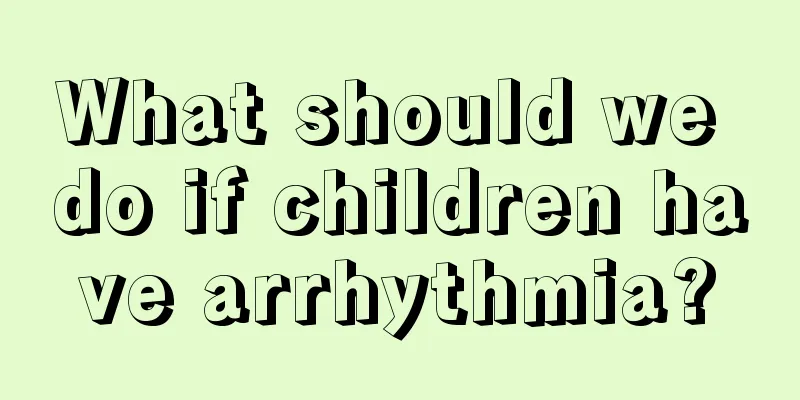What should we do if children have arrhythmia?

|
The anatomical and physiological basis of arrhythmia is that the cardiac conduction system has a very good function of tripping cardiac excitation, that is, autonomy. Two types of myocardial cells can receive and transmit cardiac excitation, namely, excitability and conductivity. Working myocardial cells have no autonomy under physiological conditions, but can form excitement under pathological conditions. So what should we do when children have arrhythmia? ① Autonomy: Autonomy comes from the pacemaker cells of the cardiac conduction system. Their electrophysiological characteristics are different from those of general myocardial cells. Their resting potential is unstable and they undergo automatic slow depolarization. Once the threshold potential is reached, spontaneous depolarization occurs and excitement occurs. ② Stress: The myocardium can respond to stimulation of a certain intensity, which manifests as electrical activity and mechanical contraction. After receiving stimulation, the myocardium undergoes a series of changes in its excitability. After one stimulation, it does not respond to subsequent stimulation. This period is called the refractory period. In the initial stage of the refractory period, no reaction occurs, which is called the absolute refractory period. In the subsequent short period, only strong stimulation can cause a weak reaction, which is called the relative refractory period. The refractory period in different parts of the heart varies in length, with the atrioventricular node being the longest, followed by the ventricular muscle, and the atrium being the shortest. The right bundle branch is longer than the left bundle branch. Under normal circumstances, the refractory period of ventricular muscle is roughly equivalent to the QT interval in the electrocardiogram. The period before the T wave peak is the absolute refractory period, and the period after it is the relative refractory period. The slower the heart rate, the longer the refractory period, and the faster the heart rate, the shorter the refractory period. At the beginning of the ventricular relative refractory period, which is approximately equivalent to the peak of the T wave, its excitability can be abnormally enhanced, and weak stimulation can lead to a strong reaction, which is called the vulnerable period. If ventricular premature beats occur at the peak of the T wave, they can easily cause ventricular tachycardia. A very short period of time after the refractory period is called the supernormal period, during which the threshold potential required for a reaction is lower. ③Conduction: The myocardium can conduct impulses to adjacent tissues. The conduction velocity in different parts of the heart is different. The slowest is in the atrioventricular junction at 50-200 mm/s, the fastest is in the Purkinje fibers at 4000 mm/s, the atrioventricular bundle at 1000-1500 mm/s, and the ventricular muscle at 300-400 mm/s. The conductivity of the myocardium is closely related to its stress resistance. The conduction is interrupted during the absolute refractory period of the myocardium, and the conduction speed is significantly slowed down during the relative refractory period. This physiological phenomenon is called interference. If the refractory period is abnormally prolonged, conduction block occurs. Under normal circumstances, the sinoatrial node produces the highest frequency of excitement, controls the entire heart activity, serves as the heart's pacemaker, and forms sinus rhythm. When the pacing function of the sinoatrial node is impaired, the next-level conduction system, usually the junction area, can replace the sinoatrial node as the pacemaker of the heart to maintain the contraction and relaxation activities of the heart, forming an escape beat or escape rhythm. If the autonomy of pacemakers other than the sinoatrial node increases, it exceeds the sinoatrial node and controls part or all of the heart activity, resulting in premature beats or ectopic tachycardia. In recent years, the study of myocardial electrophysiology has shown that the atrioventricular junction can be divided into three parts from top to bottom: the atrial node area, the node area and the terminal area. The knot area has no autonomy. Under normal circumstances, the sinoatrial node has the highest frequency of excitement. It controls the activity of the entire heart and is the pacemaker of the heart, thus forming the sinus rhythm. When the sinus rhythm function is impaired, the next-level conduction system will usually allow the junction area to replace the sinoatrial node as the pacemaker of the left heart. |
<<: What causes vaginal bleeding in baby girls?
>>: Reasons for a 17-month-old baby to have a fever
Recommend
Can children use adult eye drops?
Generally speaking, medicines are universal, whic...
How to correct a baby's crooked head?
Many unexpected situations may occur during the g...
The main reason why babies always shake their heads when sleeping
In life, many careful mothers will observe that t...
Children with autism have many obstacles in their performance!
Autism can be said to be a mental illness, and in...
Acne on the face of a child
Acne is a skin disease that often occurs on the f...
How to improve the physical fitness of primary school students?
People's lives have generally improved, but t...
What causes fetal hemangioma?
In the clinical practice of children's diseas...
What to do if your four-year-old baby has prickly heat
Prickly heat is a skin disease, and the incidence...
Children have diarrhea with mucus
Children's diarrhea with mucus is mainly caus...
The causes of precocious puberty in children
Some children develop secondary sexual characteri...
The importance of fundus examination in premature infants
Fundus examination of premature infants is a part...
What to do if your child coughs and has yellow phlegm
Coughing is a common symptom. The occurrence of t...
What to do if your child has a fever
Every child’s growth from childhood to adulthood ...
When should I be discharged from the hospital for premature delivery at 31 weeks of pregnancy?
Premature birth at 31 weeks is quite harmful to t...
What medicine is good for children's gastrointestinal cold
The healthy growth of children has always been a ...









